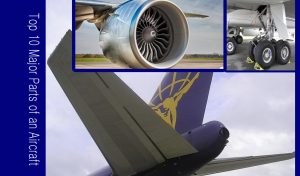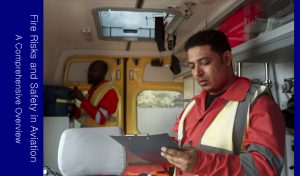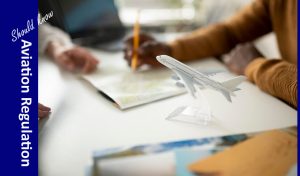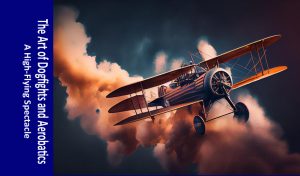Airfield lighting systems are crucial components of an airport’s infrastructure, designed to guide planes accurately for the duration of all levels of flight, particularly at some stage in takeoff and touchdown. These structures are vital for making sure aviation protection, specifically all through adverse weather situations, low visibility, and night time operations. Here’s a top level view of airfield lighting fixtures structures and their significance. Let’s know How Airfield Lighting Systems Work.
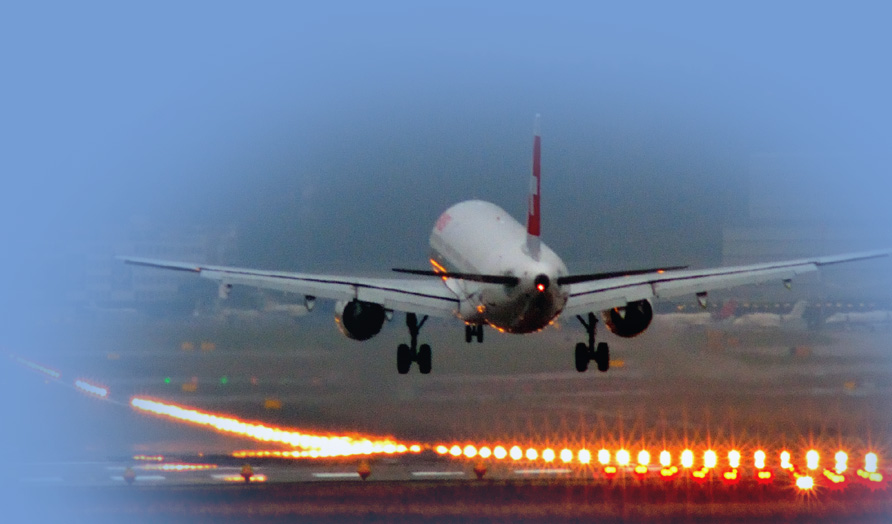
Runway Edge Lighting System:
Runway edge lighting fixtures are a critical factor of airport lighting structures and play a critical function in ensuring the safe operation of plane at some point of takeoff, touchdown, and taxiing. These lighting are set up alongside the edges of a runway and are designed to offer visual guidance to pilots, specifically in low-visibility situations which include for the duration of night time operations or in detrimental weather.
Key features of runway edge lights include:
- Color and Configuration: Runway edge lights are typically white, but they can also be yellow on some runways, depending on local regulations and international standards. These lights are arranged in a specific pattern to provide a continuous line of visual reference for pilots.
- Spacing: The spacing between runway edge lights is standardized, with specific distances between lights to maintain a consistent and easily recognizable visual reference for pilots. The spacing may vary depending on the category and size of the airport.
- Intensity: Runway edge lights are designed to be visible from a considerable distance. They are bright and intense to ensure that they can be seen by pilots even in adverse weather conditions, such as heavy rain, fog, or snow.
- Directional Lighting: These lights are designed to indicate the lateral boundaries of the runway. They help pilots stay aligned with the runway centerline during takeoff, landing, and taxiing. When viewed from the air, runway edge lights appear as a continuous line of light, helping pilots maintain proper alignment.
- Low-Intensity Lighting: Some airports have a system of low-intensity runway edge lights for use during periods of reduced visibility (e.g., during nighttime). These lights are dimmer than the high-intensity lights but still provide adequate visual guidance.
- High-Intensity Lighting: During takeoff and landing, high-intensity runway edge lights may be activated to provide maximum visibility for the pilot. These lights are brighter and are intended for use when visibility is reduced.
- Runway Holding Position Lights: In some cases, special lights are installed at the intersection of runways and taxiways to indicate holding positions for aircraft. These lights help prevent runway incursions.
- LED Technology: Many modern airports are transitioning to LED (Light Emitting Diode) technology for runway edge lights due to its energy efficiency, longer lifespan, and superior visibility.
Taxiway Lighting System:
Taxiway lights is another crucial factor of airport lights systems designed to help aircraft throughout ground movements, in particular when they’re taxiing between the runway, apron, and terminal regions. These lights assist pilots navigate the taxiways effectively and successfully, making sure the general flow of plane actions at an airport.
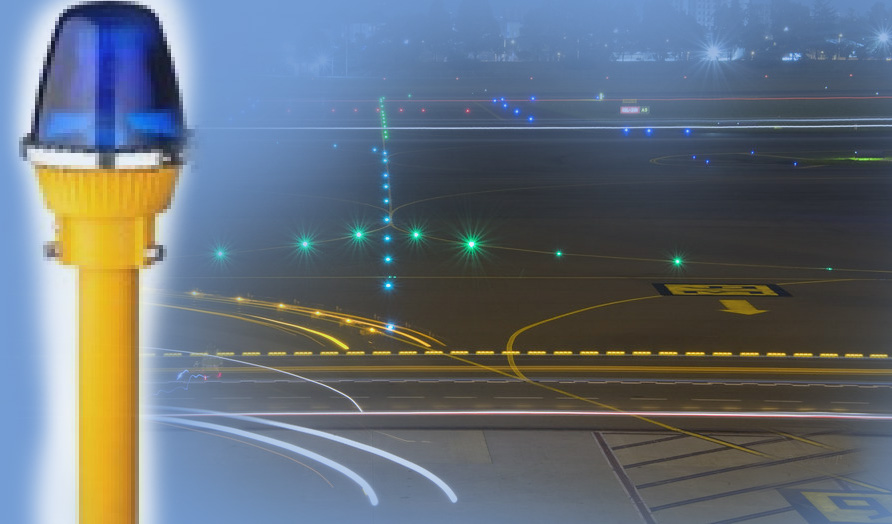
Here are the key features of taxiway lighting:
- Color and Configuration: Taxiway lights are typically blue in color. They are arranged in a specific pattern to outline the edges of taxiways and intersections clearly. The specific configuration can vary depending on the airport’s size, complexity, and local regulations.
- Spacing: The spacing between taxiway lights is standardized to provide pilots with a consistent and easily recognizable visual reference. The distance between lights varies depending on factors like the taxiway’s importance and the airport’s classification.
- Intensity: Taxiway lights are designed to be visible during day and night, as well as in adverse weather conditions. They are typically less intense than runway edge lights since taxiing speeds are slower than takeoff and landing.
- Centerline Lights: Some taxiways, particularly those leading to or from runways, have centerline lights. These lights are white and run down the center of the taxiway, helping pilots maintain proper alignment during taxiing operations.
- Edge Lights: In addition to centerline lights, there are also blue taxiway edge lights that outline the taxiway’s boundaries. These help pilots navigate safely, especially during nighttime or in low-visibility conditions.
- Holding Position Lights: Taxiways leading to runways may have holding position lights, indicating where aircraft should stop before entering the runway. These lights help prevent runway incursions.
- Clearance Bar Lights: At some airports, clearance bar lights are used at runway holding positions to signal to pilots that they are cleared to cross or enter the runway.
- Direction Signs: Taxiways are also equipped with illuminated signs that provide directions to pilots, helping them find their way to the correct runway, gate, or other airport facilities.
- Rapid Exit Taxiway Lights: Rapid exit taxiways, which allow aircraft to leave the runway quickly after landing, often have lights to guide pilots on the correct path.
- LED Technology: Like runway edge lights, many airports are transitioning to LED technology for taxiway lighting due to its energy efficiency, longer lifespan, and superior visibility.
Approach and PAPI Lights:
Approach lights structures (ALS) and Precision Approach Path Indicator (PAPI) lighting fixtures are critical additives of airport lighting fixtures that useful resource pilots at some point of the very last stages of their method and touchdown, supporting them preserve the right flow path and touch down effectively on the runway. Here’s an overview of these structures:

- Approach Lighting System (ALS):
- Purpose: The ALS provides a visual reference to pilots during the critical phase of their approach to the runway, helping them establish and maintain the correct glide path and alignment.
- Configuration: ALS configurations can vary depending on the airport’s size, runway type, and operational needs. However, a typical ALS consists of a series of light fixtures and arrays that extend outward from the runway threshold and guide the aircraft on a proper glide path.
- Lighting Types: ALS can include various types of lighting fixtures, such as sequenced flashing lights, strobe lights, and runway end identifier lights (REILs). REILs are often placed at the runway’s threshold to provide additional visual cues.
- Sequenced Flashing Lights: These lights are arranged to provide a descending or variable approach path. They may include both white and red lights, with the red lights indicating the runway’s last 1,000 feet.
- Strobe Lights: Strobe lights are positioned in a row along the approach path and are activated when visibility is reduced.
- Distance Markers: ALS often includes distance markers that help pilots gauge their progress along the approach. These markers are typically placed at specific intervals and may display the distance to the runway threshold.
- Intensity: The ALS lighting is generally brighter and more intense than other runway and taxiway lights to ensure visibility during various weather conditions.
- Precision Approach Path Indicator (PAPI) Lights:
- Purpose: PAPI lights are a specific subset of ALS designed to provide precise vertical guidance to the pilot during the approach phase. They help the pilot maintain the proper glide path for a safe and accurate landing.
- Configuration: PAPI lights consist of a row of light units, typically four in number, placed to the side of the runway near the threshold. They project a visual indication to the pilot.
- Color Coding: PAPI lights use a combination of red and white lights to indicate the aircraft’s position relative to the desired glide path. When the pilot is above the desired path, more white lights are visible, and when below the path, more red lights are visible.
- Visual Cues: A pilot flying the correct glide path should see two red and two white lights, which indicates the ideal approach angle for a safe landing. If the pilot sees more white lights, it means they are too high, and if they see more red lights, they are too low.
- PAPI Light Accuracy: PAPI systems are designed to provide a highly accurate and consistent glide path reference, making them valuable tools for maintaining approach precision.
Visual Aids:
Visual aids at an airport are quite a number equipment and gadgets used to provide visible steerage and facts to pilots and ground personnel. These aids are crucial for safe and green airport operations, specially in damaging climate conditions or throughout middle of the night operations. Here are some common varieties of visual aids determined at airports:
- Runway Markings: These include painted lines, symbols, and signs on the runway’s surface that provide information to pilots about runway designations, threshold markings, aiming points, touchdown zone markings, and more.
- Taxiway Markings: Taxiways have painted markings and signs to guide pilots as they taxi between runways, gates, and other areas of the airport. These markings include centerline stripes, edge lines, and holding position markings.
- Signs: Airport signs are used to provide directions, information, and warnings to pilots and ground vehicle operators. They can include taxiway signs, runway exit signs, holding position signs, and many others.
- Windsocks: Windsocks are placed near runways and helipads to indicate wind direction and relative wind speed, helping pilots make informed decisions during takeoff and landing.
- Visual Glide Slope Indicators (VGSI): VGSI systems include PAPI and VASI lights, which provide visual cues to pilots to maintain the correct glide path during approach and landing.
- Approach Lighting Systems (ALS): ALS systems are used to guide pilots during the final approach phase to the runway. They consist of a variety of light configurations to help pilots establish and maintain a safe glide path.
- Obstruction Lights: These lights are placed on tall structures or obstacles near the airport to make them visible to pilots and help prevent collisions.
- Beacon Lights: Airport beacon lights are used to indicate the location of an airport to pilots from a distance, especially during the nighttime. They are usually located on top of the control tower or a prominent airport building.
- Runway and Taxiway Lights: Runway and taxiway lights, including edge lights, threshold lights, and centerline lights, provide illumination for pilots during takeoff, landing, and taxiing, especially in low-light conditions.
- Apron Lighting: Apron or ramp lighting helps illuminate the areas where aircraft are parked, loaded, and unloaded. It aids ground crews in their operations and helps pilots navigate on the apron.
- Runway Guard Lights: These lights are located at the taxiway/runway intersections and serve as a visual indication to pilots about where they should stop when crossing a runway.
- Heliport Lighting: Heliport lighting includes lights on the landing pad and perimeter to assist helicopter pilots during takeoff and landing operations.
- Lighted Signs and Signals: These include illuminated signs and signals that provide important information to pilots, such as stop bars at runway-holding positions.
Threshold Identification Lights:
Threshold Identification Lights (TDIL), also known as Runway Threshold End Lights (RTELG), are a type of visible useful resource used at airports to decorate the identity of a runway’s threshold, especially at some point of reduced visibility situations. These lighting are installed at or close to the start of a runway to help pilots align their plane efficiently all through takeoff and touchdown. TDILs are specifically treasured whilst visibility is negative due to factors like fog, rain, snow, or darkness.
Here are key characteristics of Threshold Identification Lights:
- Location: TDILs are typically installed on the threshold or at the runway end to mark the beginning of the runway.
- Light Characteristics: These lights are usually unidirectional and emit a steady, white light. This helps pilots identify the threshold and provides a clear reference point.
- Arrangement: Threshold Identification Lights are often arranged in a row across the width of the runway, creating a visual bar at the threshold’s edge.
- Intensity: The lights are designed to be sufficiently bright to be visible to pilots during low-visibility conditions, ensuring that they can identify the runway’s threshold.
- Activation: TDILs are typically activated automatically when visibility drops below certain predetermined levels, such as during nighttime or when fog or other adverse weather conditions reduce visibility.
- Safety Enhancement: These lights play a critical role in enhancing runway safety by helping pilots establish the correct approach angle and touch down in the intended area of the runway. This is particularly important when there is reduced visual reference, as it helps prevent overshooting or undershooting the runway.
Apron and Ramp Lighting:
Apron and ramp lights are essential additives of airport lights systems designed to provide illumination for the areas where plane are parked, loaded, unloaded, and serviced. The apron and ramp regions are essential for floor operations and renovation activities, and good enough lighting is essential to ensure the protection and performance of those sports, specifically throughout middle of the night operations. Here’s an outline of apron and ramp lighting fixtures:
- Purpose:
- Apron and ramp lighting serve several purposes, including enhancing safety, facilitating aircraft and ground vehicle movements, and providing visual references for ground crews.
- Types of Lights:
- Apron Floodlights: These are powerful floodlights strategically placed around the apron area to provide broad, uniform illumination. They are often mounted on tall poles or structures.
- Apron Edge Lights: These lights are installed along the edges of the apron to outline its boundaries and provide guidance for aircraft and vehicles.
- Apron Floodlight Apron Edge Light Apron Floodlight Edge Light Centerline Lights: Some apron areas may have centerline lights to guide aircraft to their parking positions. These lights are similar to those found on taxiways and runways.
- Obstruction Lights: If there are tall structures, equipment, or buildings near the apron, obstruction lights are used to mark them and make them visible to pilots and ground personnel.
- Guidance Signs: Illuminated apron signs and markings are used to direct aircraft to parking spots, gates, and service areas.
- Apron Floodlight Apron Signs: These signs may be illuminated for better visibility during nighttime or adverse weather conditions.
- Intensity and Brightness:
- Apron lighting is typically designed to be bright and intense, ensuring visibility even during adverse weather conditions or limited visibility.
- Flexibility: Many apron lighting systems are designed to be adjustable or dimmable to conserve energy when full illumination is not required.
- Automation: Apron lighting can be controlled and activated automatically based on ambient light conditions, time of day, or the presence of aircraft or vehicles.
- Energy Efficiency: To reduce operational costs and environmental impact, many airports are transitioning to energy-efficient lighting technologies, such as LED lights.
- Safety Enhancement: Adequate apron and ramp lighting enhances safety by reducing the risk of accidents, especially when aircraft are taxiing, loading, or unloading. It also helps ground crews work safely during nighttime operations.
- Compliance: Airport lighting, including apron and ramp lighting, must comply with international and local regulations and standards to ensure consistency and safety across airports worldwide.
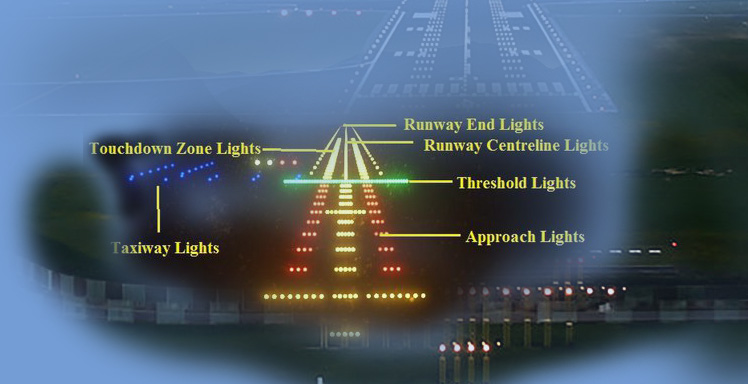
Sequenced Flashing Lights:
Sequenced Flashing Lights (SFL) are a sort of lights system used in aviation to assist pilots in the course of the very last approach segment and landing on a runway. They are a aspect of the Approach Lighting System (ALS) and are designed to beautify the visual cues for pilots, specially in low-visibility situations or throughout midnight operations. Here’s an overview of sequenced flashing lighting:
- Purpose:
- The primary purpose of sequenced flashing lights is to guide pilots as they approach the runway threshold and establish a safe glide path for landing.
- Configuration:
- Sequenced flashing lights are typically arranged in a row extending from the runway threshold. They are situated in such a way that they provide a descending or variable approach path for the aircraft.
- Color and Intensity:
- Sequenced flashing lights are usually white in color. They are designed to be bright and highly visible, ensuring that pilots can see them from a distance and during various weather conditions.
- Lighting Pattern:
- The lighting pattern of sequenced flashing lights is dynamic and variable. It consists of a sequence of flashes or light segments, with specific timing and intervals between them.
- The lights may include both steady and flashing components, creating a visual reference that helps pilots gauge their altitude and alignment.
- Visual Cues:
- The lighting pattern of sequenced flashing lights provides visual cues to pilots about their descent and alignment with the runway threshold.
- A standard visual cue typically consists of a series of white steady lights and red flashing lights, with the red lights indicating the last 1,000 feet of the runway.
- Sequencing:
- The lights are sequenced in a specific manner to give the illusion of a descending path. This sequencing is carefully designed to help pilots maintain the correct approach angle and altitude during the final phase of landing.
- Safety Enhancement:
- Sequenced flashing lights play a crucial role in enhancing the safety of aircraft landings. They help pilots establish and maintain the correct glide path, reducing the risk of undershooting or overshooting the runway.
- Variability:
- The sequencing of the lights can be adjusted to accommodate different approach angles and runway configurations, making them versatile and adaptable to various airport layouts.
High-Intensity Runway Lights (HIRL) and Medium-Intensity Runway Lights (MIRL):
High-Intensity Runway Lights (HIRL) and Medium-Intensity Runway Lights (MIRL) are two types of lighting systems used on runways at airports:
- HIRL (High-Intensity Runway Lights):
- HIRL are bright runway lights used for primary runway lighting.
- They are used for takeoff and landing operations, providing maximum visibility for aircraft.
- HIRL are typically used at larger airports with longer runways.
- These lights are especially important during low-visibility conditions.
- MIRL (Medium-Intensity Runway Lights):
- MIRL are runway lights with moderate brightness.
- They are used on shorter runways or at airports with less traffic.
- MIRL provide adequate visibility for takeoff and landing but are not as intense as HIRL.
- They are often used for smaller general aviation airports.
Both HIRL and MIRL play a critical role in ensuring the safe operation of aircraft during takeoff and landing, with their intensity and application varying depending on the airport’s size and operational requirements.
In Conclusion, It’s vital for pilots to have a radical information of airport lights systems and the way they could use those systems to make certain safe takeoff, landing, and taxiing operations, in particular in conditions in which visibility is restricted or at some stage in nighttime operations. The tick list serves as a quick connection with make certain that every one relevant components of the lighting device are accounted for for the duration of pre-flight and in-flight techniques.
